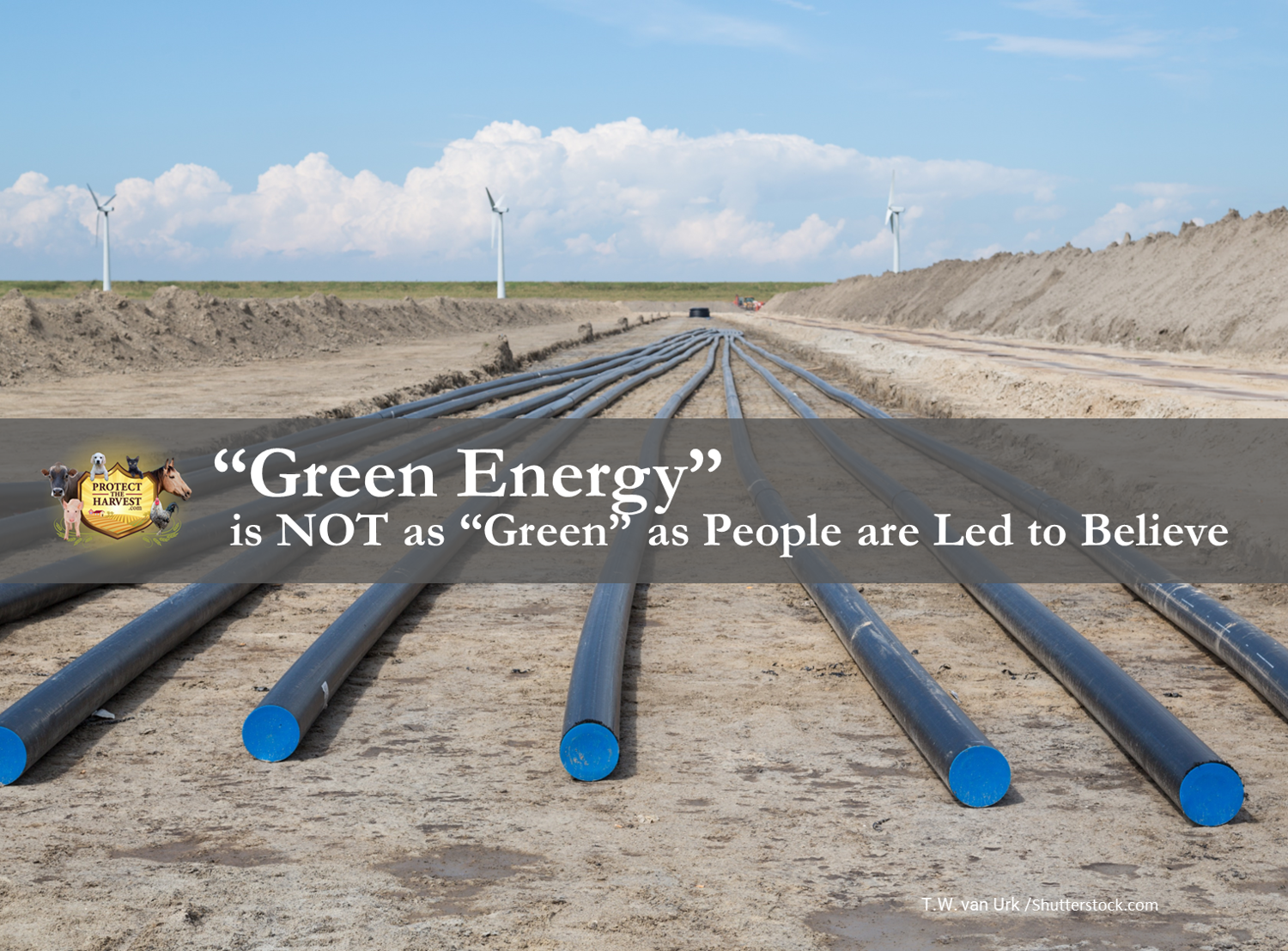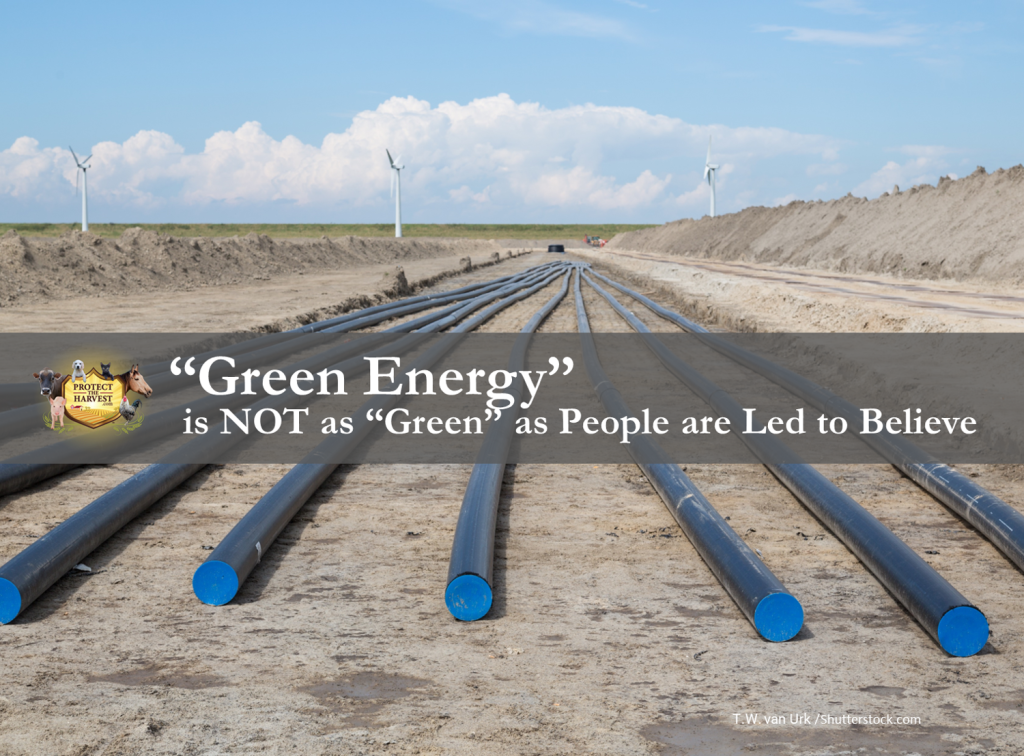
NOT SO GREEN ENERGY
Green energy is almost always presented as beneficial to the health of our planet. This sounds great, and it is great when “green” energy is actually “green.” What proponents of green energy often don’t talk about is the larger shadow and what goes into the production, maintenance, and eventual disposal of the components utilized to create energy that “burns green.” To discover the real issues with green energy we must take a look at what it is and the effects it is having on our planet. Many of these green energy plans will do more harm than good in the long run.
According to a Los Angeles Times article, a study conducted by the Nature Conservancy predicted that 21 million acres of land would be needed in order to power the Western United States. To put it in perspective the article states that this would be roughly half of the size of the state of Utah. The article also states: “The Nature Conservancy estimates a need for 6,259 miles of new power-line corridors.”
The construction of new powerline corridors will have its own, massive environmental impact.
Wind Turbines
Wind turbines are at the top of the list when it comes to the false benefits of green energy. The intended purpose of wind turbines is to produce electricity without pollution. On the surface, the use of wind turbines seems like a fantastic idea. Once constructed, they can produce energy from the wind turning blades that crank electricity-producing turbines. However, the environmental damage that the creation, installation, and disposal of expended wind turbines is far greater than the benefits realized by the energy they actually produce.
Wind Turbine Fabrication, Installation, and Maintenance
In all aspects, wind turbines are costly to build, install, and maintain. Wind turbines are made of steel, fiberglass, iron, copper, and aluminum. Steel is made using the combustion of metallurgical coal in blast furnaces. These emit the same pollutants that wind turbines are “saving” us from.
Wind turbines are so large that they must be transported in pieces via special semi-trailers and then assembled on-site. Due to their size, there is considerable site prep that must occur prior to installing wind turbines. Site prep includes clearing of land, grading for maintenance roads, trenching, and grading. Gigantic concrete footings are poured in order to create a stable base for the turbines.
In addition to the expense of installation, wind turbines are reported to cost upwards of $42,000 per year to maintain and run. The life span of a turbine is somewhere between 20 and 25 years.
Disposal
Wind turbine disposal has a large environmental footprint. The wind turbine blades are massive, spanning 170 feet. Turbine blades are made of fiberglass, which does not decompose. They are also incredibly durable and built to withstand hurricane-force winds. This durability makes the blades difficult to recycle or crush. When they are disposed of, they are cut into three segments and are either taken to landfills or cement factories. Burning is not an option for wind turbines as the fiberglass material is incredibly toxic to the environment.
According to a 2019 article by NPR, the United States alone will have to dispose of 720,000 tons of turbine blade materials within the next twenty years. In Europe, it is predicted 1,400 turbines will be taken down by the end of 2023. Those numbers convert to roughly 4,200 massive blades that will become waste.
The cost of disposal can range anywhere from $25,000 to $67,000. Leaving both a complicated and expensive task of getting rid of the blades after they are no longer in use.
Wind Turbine Danger to the Environment and Wildlife
In addition to the environmental impact of installation and disposal, while operating, wind turbines can cause harm to the environment and local wildlife. It is not uncommon for the turbines to have mechanical issues, creating leaks of gear oil, hydraulic fluid, and grease. These flammable materials can ignite, burning the wind turbine itself and starting wildfires.
The U.S. Geology Service released information that shed light on the amount of wildlife harmed by wind turbines. The impact of wind turbine blades on wildlife, especially birds and other flying animals, is significant. The American Bird Conservatory estimates 681,000 birds are killed by wind turbines in the U.S. annually.
In addition to bird deaths, the blades are affecting native bat populations. After conducting copious amounts of research, wind turbines are estimated to have contributed to hundreds of thousands of bat deaths in North America alone. That number does not count the casualties around the globe which is estimated to be closer to one million.
When in motion, the turbines emit a humming sound. This humming sound attracts bats since it mimics echolocation. Once the bats arrive to inspect the noise, they quickly meet the spinning blades.
Additionally, these numbers do not include bird and bat mortality counts which are not detected by humans.
Wind Turbine Impact on Air Temperature
Wind turbines have been found to affect local weather patterns and air temperatures. A study done by PNAS showed that there is an obvious difference in surface air temperature in the surrounding areas of wind farms after they are constructed. Data showed that during the night and early morning the air temperatures upwind from wind farms are higher than areas downwind from them. The effect is reversed during the day. A heating effect can be observed at night while a cooling effect is apparent during the day. Most people will agree that nights are often cooler than days as the sun is gone and it allows temperatures to cool. This reversal of temperatures can have effects on livestock, crops, and even people in the surrounding area.
If this is the case, are wind farms helping or harming the climate, especially since their numbers are increasing by the tens of thousands?
Solar Energy
Solar energy is another “green” energy misnomer that is sold to the public as an environmentally conscious source of electricity. Instead of being environmentally friendly, massive solar panel arrays have been found to cause land alteration, a strain on water resources, and wildlife habitat loss.
Manufacturing and Materials
Solar panels may convert energy from the sun and turn it into electricity, but the materials and manufacturing process used to create these panels have their own, environmental footprint. This includes mining for the materials, transportation, energy used to manufacture the panels themselves, and so on.
Land Use
Large solar farms have a massive ecological footprint. They require thousands of acres of clear land. The construction of solar farms involves clearing vast swaths of land of vegetation, trenching and installing infrastructure to store and deliver the energy created by the panels, and creating maintenance roads. All of this leads to the destruction of natural ecosystems and displaces many species of wildlife.
Water
Most people are unaware that solar panels can have a water consumption footprint. Large solar arrays require cooling. According to an article by the Union of Concerned Scientists, a concentrating solar thermal plant can use anywhere from 600 to 650 gallons of water per megawatt per hour for cooling. For reference, according to information found on the website, freeingenergy.com, one megawatt of energy can power two modern refrigerators for a year. The New York Times reports that there are around 35 million households in the US that have two refrigerators. 600 gallons of water multiplied by 35 million, comes to 21 billion gallons of water to produce enough solar electricity to power two refrigerators in American households for a year.
Disposal
Solar panels create another environmental challenge when they are disposed of at the end of their use. Unfortunately, the materials they are made of are not easily recycled. Solar panels are primarily made of silicon, which is not biodegradable. Like wind turbine blades, spent solar panels often end up in landfills. According to the Environmental Protection Agency (EPA) by 2030, “the United States is expected to have as much as one million total tons of solar panel waste,” and by 2050, “the United States is expected to have the second largest number of end-of-life panels in the world, with as many as an estimated 10 millions total tons of panels.”
Hazardous Waste
Like wind turbines and wind turbine blades, solar panels can be considered hazardous waste. According to the EPA, “Hazardous waste testing on solar panels in the marketplace has indicated that different varieties of solar panels have different metals present… Some of these metals, like lead and cadmium, are harmful to human health and the environment at high levels.”
Stopping “Green” Energy’s Harmful Impact
Finding ways to provide energy for our growing nation is important. It is equally important to continue to look for ways to provide energy with smaller and smaller environmental footprints. In the rush to jump on the bandwagon of “green” solutions the public only focuses on the end use of green energy instead of the overall and long-term impacts. When it comes to protecting our environment, the rush to implement “green” energy in many cases, will push us backward instead of forward.
It is important to always consider the full footprint and to look beyond the green energy ideas that are being presented, and in some cases forced on us by those with financial interests in the latest technology.
Our food security as a nation is reliant upon access to affordable, practical energy. Our food security is also reliant upon a healthy environment and the best use of resources.
Links
Bloomberg Article – Wind Turbine Blades Filling Up Landfills HERE
ReCharge News – HERE
NPR Article – Unfurling the Waste Problem Caused by Wind Energy HERE
Environmental Impacts of Solar Power HERE
Information About Megawatts of Energy HERE
Dark Side of Solar Power HERE
LA Times Article – Environmental Impact of Solar and Wind Farms HERE
EPA – End LIfe Solar Panel Regulations HERE
US Geological Service – Can Wind Farms Harm Wildlife HERE
Medium – Why Solar Panels Are Not 100% Green HERE
Birds – Wind Turbine Mortality HERE




